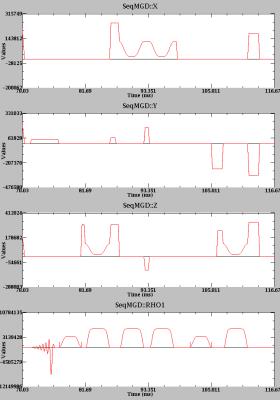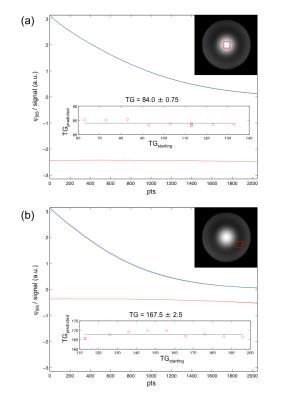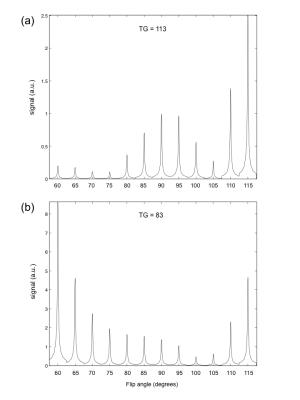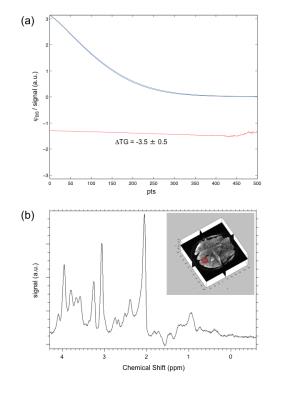5509
Voxel Based Transmit Gain Calibration using Bloch-Siegert semi-LASER at 7T1GE Healthcare, Berlin, Germany, 2INFN and Department of Physics, University of Pisa, Pisa, Italy, 3IMAGO7 Foundation, Pisa, Italy, 4IRCCS Stella Maris, Pisa, Italy
Synopsis
A voxel-based implementation of the Bloch-Siegert phase shift method within a semi-LASER based localization sequence that shows a high robustness to determine transmit gain (TG) for the same volume that is excited for the spectroscopy experiment is demonstrated at 7T. Phantom and in-vivo measurements show higher robustness over a large range of initial TG settings and voxel locations resulting in a faster and more reliable calibration procedure to achieve good voxel selection and spectrum quality and avoid additional calibration steps.
Purpose
With the high B1 field inhomogeneity at ultra-high field the adjustment of the transmit gain (TG) on a slice might lead to miscalibration of TG in smaller target volumes. This can result in poor excitation slice profile and out-of-voxel signal suppression in single-voxel MRS. To correct for this miscalibration additional calibration steps for excitation, refocusing and water suppression pulses in a semi-LASER can be used.
The phase based Bloch-Siegert (BS) shift method has already been successfully used for TG calibration [1] and can be included in various types of imaging and spectroscopy sequences. BS-PRESS [2] and BS-STEAM [3] determine the optimal TG in the same volume that is excited for the spectroscopy experiment from the average of the BS phase shift of the first high SNR data points of the FID and have already been successfully implemented at 7T.
This study will present an implementation of the Bloch-Siegert phase shift method within the semi-LASER [4] based localization sequence that shows a high robustness to determine TG for the same volume that is excited for the spectroscopy experiment in-vivo at 7T to reduce the amount of additional calibration steps.
Methods
A semi-LASER sequence with crusher scheme described in [4] including two off-resonant Bloch-Siegert pulses (fermi, 4 ms, ± 4 kHz relative to water, KBS = 73.68 rad/G2) (Figure 1) was implemented. Experiments were performed both in a MRS phantom (MRS HD Sphere, GE Healthcare, diameter = 18 cm) and in-vivo in a whole body MR950 7T scanner (GE Healthcare) with standard head coil (Nova Medical, 2-channel Tx, 32-channel Rx) with TE/TR = 40ms/4s, 2 averages/scheme).
Data processing was implemented in MATLAB (MathWorks) as an automatic process on the scanner after scan execution. TGpredicted was calculated from the mean of the Bloch-Siegert phase shift [2] using data up to the point of the FID where magnitude signal dropped to 50% of the initial signal. TGstarting was first set by the standard slice-based multi-echo sequence in the automated prescan (APS) process [5]. In order to test the robustness of the technique, TGpredicted was calculated with TGstarting set manually over a larger range around optimal TG. Additional calibration steps acquiring water signal over a range of flip angles for excitation, refocusing and water suppression pulses were performed for TGstarting and TGpredicted. Semi-LASER spectra (TE/TR = 30ms/4s, 32 averages) were acquired with TGpredicted.
Results and Discussion
Standard deviation of TGpredicted for a large range of TGstarting in the center of the phantom was 0.75 and in the region of low signal 2.5 (Figure 2) with ΔTG of 10 equals 1dB. In the region of low signal BS semi-LASER results in ∆TG of +54.0 which didn’t lead to a maximum in the standard range of flip angles for the excitation pulse calibration (Figure 3a) while set to TGpredicted this was 90° (Figure 3c). For the center voxel the minimum signal with the VAPOR water suppression pulse calibration for TG set by APS and TGpredicted was at the same B1 of the VAPOR pulses (Figure 4). Setting of the voxel based TG allowed using a fixed range of flip angles for the following calibration steps and showed no need for changes for the excitation and refocusing flip angles while the water suppression could be optimized using a range of flip angles with smaller step size. An in-vivo example of an 8ml voxel in the right occipital lobe with the BS semi-LASER results is shown in Figure 5.Conclusion
It has been demonstrated that the proposed voxel based TG calibration using the Bloch-Siegert shift method with semi-LASER excitation allows to set TG over a large range of starting values in one step. This allowed removing the additional calibration steps for the excitation and refocusing pulses. To achieve very good water suppression with water below NAA signal this calibration step could be done with a fixed range of flip angles and small step size. In addition the correct setting of the voxel based TG effects all pulses within the sequence and therefore also the Outer-Volume-Saturation (OVS) pulses.Acknowledgements
No acknowledgement found.References
1. Sacolick et al. Magn Reson Med 2010; 63: 1315–1322
2. Toncelli et al. Proceedings of ISMRM Workshop on UHF MRI 2013; 34
3. Toncelli et al. Proceedings of ISMRM 2015; 4695
4. Öz et al. Magn Reson Med 2011; 65: 901–910
5. King et al. Proceedings of ISMRM 1995; 699
Figures




